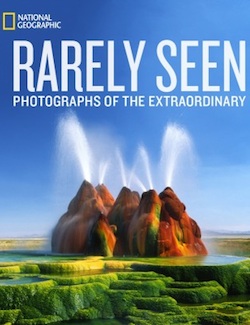By Jay M. Pasachoff
Over 100 two-page spreads (on heavy paper) of the most spectacular pictures curated by National Geographic; that should be enough to impel almost everyone to look forward to this book. And the pictures are even more impressive when looked at than the mere concept of them. The layout, the content, and the eye-catching color are wonderful to look at.
Susan Tyler Hitchcock, whose name is credited at the top but whose exact role is unspecified, is a senior book editor for the National Geographic Society. A foreword by photographer Stephen Alvarez emphasizes the use of photography in uncovering the otherwise unseen or unrecorded.
The main sections of the book are Phenomena, Life, Places,Objects, and Moments. Phenomena has, for example, spreads of a solar ice halo known as a sun dog, a tornado, a double rainbow, and a colony of lots of penguins. Moments has a selfie with the Pope.
Occasionally, brief statements from the individual photographers are reproduced large on a single page, facing a vertical photograph. Or an interesting juxtaposition is made, such as the atom smasher at CERN in Switzerland opposite a decorated ceiling in a cathedral in Spain, both with central circles surrounded by radiating features. Or the similar angular shapes of salt flats in Bolivia and the Svalbard Global Seed Bank. Or the similar circles of the Nebra sky disk in Germany from 1600 B.C. vs. a male pufferfish’s mate-attracting circle. My own photograph of a total solar eclipse is contrasted with a great blue hole surrounded by a coral atoll in Belize.
National Geographic photographers are noted for their Kodachrome slides, and Steve McCurry’s of a Rabari tribal elder in India was taken on the “last roll of Kodachrome film ever processed.” What a loss. “When you only have 36 frames, you want to make each one special, and each picture has to count,” he wrote.
The book ends with two pages of additional credits and the copyright page crediting the Society, the Book Division, and the staff for this book—but no index, alas, making it harder to look up individual locations that may have stuck in your mind.
At a moderate price, this book could grace any coffee table in the world—or a bedside table to ponder one or two of the images each night.
Astronomer and author Jay M. Pasachoff is the director of Hopkins Observatory and Field Memorial Professor of Astronomy at Williams College. He is a Visitor in the Planetary Sciences Department of Caltech. Williams College is home to the Gamma of Massachusetts Chapter of Phi Beta Kappa.




